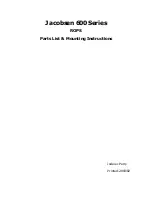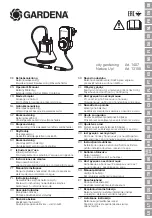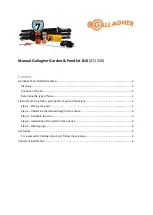
7
6
ANCHOR POINTS
The point where the fall arrest system is to be anchored should ideally be placed above the position of the user. Ensure
that the anchor device is strong enough & has a minimum strength of 12kN for metal & 18kN for textile and should be in
conformity with the EN795 requirements.
Make sure that the work is done in such a way as to limit the pendulum effect, as well as the risk and the height of a fall.
For safety reasons and before each use, make sure that in the event of a fall there is no obstacle obstructing the normal
deployment of the fall arrest system (free space under the user’s feet). Before and during use we advise you to make
the necessary arrangements for a safe rescue if the need should arise. The clearance below the feet of the user in order
to avoid collision with the structure or ground in a fall may vary depending on the type of equipment used within the fall
arrest system. Please refer to your equipment specifications to find the required clearance to the ground.
CONFINED SPACE & RESCUE HARNESS
After the fall, the victim must be rescued to avoid jamming of blood vessels caused by stress (suspension trauma). In
order to limit the risk of suspension trauma a rescue of a fallen casualty must be facilitated in a safe and speedy manner.
The Confined Space Harness Attachment shall not be used in a fall arrest system.
The confined space harness is
intended to be worn during normal working activities and that the user should carry out a suspension test in a safe place
before using the rescue harness for the first time, to ensure that it is the correct size, has sufficient adjustment and is of
an acceptable comfort level for the intended use.
SUSPENSION APPLICATION
EXTENDED SUSPENSION: A full body harness is not intended for use in extended suspension applications. If the user
is going to be suspended for an extended length of time it is recommended that some form of seat support be used.
LIMITATIONS
• Do not use if you have any medical conditions which could affect your safety in both normal and emergency use.
• The equipment shall only be used by a person trained and competent in its safe use.
• A rescue plan shall be in place to deal with any emergencies that could arise during work.
• Do not make any alterations or additions to the equipment without the manufacturer’s prior written consent.
• The equipment should not be used outside its limitation, or for any purpose other than that for which it is intended.
• The product should be a personal property of its user.
• Ensure the compatibility of items of equipment when assembled into a system.
• It is important to check before use for any dangers that may arise by the use of combinations of equipment in which the
safe function of any one item is affected by or interferes with the safe function of another.
• Carry out a pre-use check of the product, to ensure that it is in a serviceable condition & operates correctly before it is used.
• Withdraw from use any equipment where there is any doubt about its condition for safe use or if it has been used to
arrest a fall. Do not use again until it is confirmed by a competent person.
• When intended to be used in a fall arrest systems, it is essential for safety that the anchor device or anchor point
should always be positioned and the work carried out in such a way as to minimise both the pendulum and the potential fall distance.
• When intended to be used in fall arrest systems, it is essential for safety to verify the free space required beneath the user at the
workplace before each use, so that in case of a fall there will be no collision with the ground or other obstacle in the fall path.
• Be aware of hazards that may affect the performance or cause failure of the equipment, such as:
• extreme temperatures (below -15°C and above +50°C)
•
aggressive environmental conditions including sand & grit, cement, hot surfaces, naked flames, welding
spatter, sparks, electrical conductivity
• contact with: sharp edges, abrasive surfaces, chemicals
• Immediately stop using the product if it is exposed to any of the above or is damaged in any way until it has been
inspected by a competent person.
•
Ensure that the date of first use is recorded in this instruction booklet.
• If this harness forms part of a fall arrest system it must be used in conjunction with a fall arrest lanyard to EN355. This
lanyard must be inspected and be in useable condition to limit the impact forces following a fall to a maximum of 6kN.
Summary of Contents for FAR0204
Page 64: ...127 126 12 kN 18 kN EN795...
Page 66: ...131 130 E mail D...





































